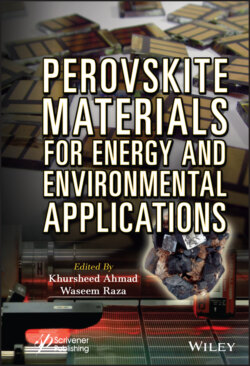Читать книгу Perovskite Materials for Energy and Environmental Applications - Группа авторов - Страница 42
2.5 Properties 2.5.1 High Optical Absorption
ОглавлениеThe absorber layer is generally referred to as the heart of the solar cell. The material of this absorber is made of organic inorganic hybrid perovskite. This absorber material has a direct band gap with high absorption coefficient. These properties have permitted to be used as very thin compact absorber materials for gathering light which have thickness in the range of hundreds of nanometers. Whereas the thickness of the film for the traditional solar cell (silicon and germanium) is the range of one micrometer to hundreds of micrometers.
Out of the three generations of solar cell, the first-generation absorber is an indirect bandgap semiconductor material. In this type of semiconductor, the minimum value of conduction band and maximum value of valence band does not lie for the same value of k. Because of this, the momentum of the electron in conduction and valence band is different.
In indirect bandgap semiconductor, transition of photon is horizontal in nature; hence, the momentum of photon is comparatively larger. So a large change of momentum is required for electron-hole pair recombination, hence momentum is not conserved here as k value for both the bands is different. Hence, a large change in momentum is required for recombination of the electron-hole pair as compared with direct bandgap semiconductors. So there is a prohibition for transition of electrons between these two levels and the transition becomes weak because of the participation of lattice vibrations during excitation. Hence, the probability of transition is lower in indirect band gap material than those in direct band gap material. Thus, the thickness of the absorber material of indirect bandgap semiconductor is way more than that of direct band gap semiconductor material for absorbing identical number of photons per unit area [32]. Because of this, for achieving alike efficiency, there is a rise in cost of production of indirect bandgap semiconductor material solar cells as compared with direct band gap semiconductor material solar cells.
Figure 2.7 Transitions in direct and indirect semiconductor [33].
Second-generation absorber material (GaAs) and perovskite (CH3NH3PBI3) have direct band gap; hence, they have high optical absorption properties compared to silicon. However, their electronic configuration of both the absorbers is not the same as shown in Figure 2.7. The lower part of conduction of gallium arsenide is obtained from the delocalized s orbitals, whereas the lower part of CH3NH3PBI3 mainly consists of Pb p bands. The p orbital is less dispersed as compared to s orbitals [33]. Hence, in GaAs, the transition efficiency is moderate. There is a high probability of transition from intra-atomic Pb s to Pb p, because of this, in CH3NH3PBI3, the transition probability between the two bands is almost equivalent to GaAs [33]. Therefore, the optical absorptions are stronger in halide perovskites than GaAs.
